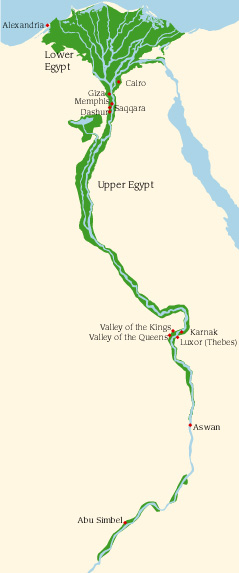

The Life of an Ancient Egyptian Pharaoh
The mighty pharaoh surveyed his court.
His subjects bowed in worship before him, kneeling and kissing the
ground. To them he was a god, an
equal to the great god Osiris. The great palace hall filled with silence as they awaited his
commands.
The Great House
Pharaoh's Court
Traveling Throughout the Country
Trade with Other Lands
How Do We Know That?
The pharaohs were the undisputed rulers of Egypt.
They were revered as gods, and their commands were absolute law.
Pharaohs lived privileged lives far removed from the common population of
Egypt. The Egyptian word “pharaoh,” or “pero” in Greek, was a title
meaning "Great House." The
enormous palace estate was a representation of the power and wealth given to a
pharaoh. Many festivals and religious celebrations were held at the palace.
The Great House
Egypt was the wealthiest country of the ancient world.
The pharaohs buil t palaces that had many rooms and stood several stories
high. Tall pillars surrounded the whitewashed bricks of the palace entrance.
The inside of the palace usually had high ceilings that allowed cool
breezes to circulate the air. Palaces
resembled little villages because many people worked and lived there.
t palaces that had many rooms and stood several stories
high. Tall pillars surrounded the whitewashed bricks of the palace entrance.
The inside of the palace usually had high ceilings that allowed cool
breezes to circulate the air. Palaces
resembled little villages because many people worked and lived there.
Many rooms were built to accommodate the pharaoh's large
family, servants, and advisors. There were private chapels, dressing rooms and
bedrooms for the pharaoh's family. Offices
were built for his ministers. Guardrooms
and quarters for servants and soldiers were also contained inside the palace
complex. Palaces also included
gardens, pools and even artificial lakes.
Top of Page
Pharaoh's Court
A great reception hall, referred to as the pharaoh's court, was a special room
where the pharaoh held festivals and received royal visitors.
These visitors came from countries such as Nubia, Lebanon, Cush and Punt. They would approach the pharaoh with expensive and rare gifts
from their land. Some countries would try to make peace with the pharaoh after
losing a battle by giving costly gifts in return for the pharaoh’s
forgiveness.
Top of Page
 Traveling Throughout the Country
Traveling Throughout the Country
The pharaoh and his royal advisors would
travel to different provinces, called nomes, throughout the Egyptian country.
Making his way by boat on the Nile River, the pharaoh would stop at
cities and towns along the way. He
would meet with the regional governors, called nomarchs, and visit the temples.
Top of Page
Trade
with Other Lands
The pharaoh oversaw all Egyptian trade with
other countries and regions. Lebanon
supplied Egypt with wood since trees would not grow in Egypt’s hot desert
climate. The prince of Nubia
supplied gold, semi-precious stones and exotic animals to the Egyptians. Many
ancient Egyptian trade expeditions went to Punt in eastern Africa to trade for
incense.
Top of Page
How Do We Know That?
Pharaoh Akhenaten ruled during the Middle Kingdom.
During his reign, he built two official palaces in the city of Amarna. One
was stone and the other was mud brick, and they were both connected by a bridge.
The stone palace was the official palace and contained storerooms, harem rooms,
and large reception rooms with high painted ceilings and decorated, white
plaster walls. The mud brick palace had a flat roof resembling the homes of many
wealthy Egyptians. The grounds of these palaces included an aviary and a pool
that was surrounded with paintings of the pharaoh’s enemies.
When he walked around the pool, the pharaoh seemed to be walking on his
enemies!
Top of Page
Some images on this page are © 2000-2001 www.arttoday.com.